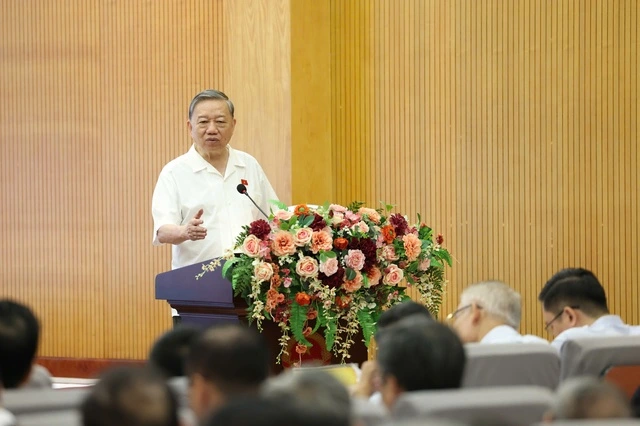(NLDO) - The Ministry of Health proposed to abolish regulations on handling violations of population policies that are no longer appropriate, including not disciplining party members who have a third child or more.
Not handling or disciplining party members who have a third child or more in line with amending legal regulations. This is the content of a recent document from the Party Central Office announcing the Politburo's opinion on amending Party and State regulations related to population policy.

Population policy is being adjusted to suit the new situation.
Previously, according to many regulations, including the 2017 Central Resolution on population policy in the new situation, having a third child was considered a violation of population policy and could be subject to disciplinary action, except in a few specific cases.
This regulation was issued to promote the pioneering and exemplary role of cadres and party members in implementing population policies and at the same time limit births to avoid population explosion.
In recent years, when analyzing population policy, many experts believe that this regulation needs to change. Having children should be considered the responsibility, obligation and right of each individual, contributing to ensuring the sustainable development of the country.
Professor Nguyen Dinh Cu, former Director of the Institute of Population and Social Issues (National Economics University, Hanoi), said that the policy of "not disciplining party members who have a third child or more" is very urgent, especially in the context of Vietnam's birth rate showing a sharp downward trend, especially in urban areas.
This expert assessed that if implemented, the above regulation would be a breakthrough in policy, contributing to improving and preventing the current decline in birth rate, "paving the way" for amending other regulations, specifically amending the 2008 Population Ordinance, building the Population Law, creating synchronous regulations in the political system.
According to the Ministry of Health, from 1999 to 2022, Vietnam's fertility rate remained stable around the replacement level (2.1 children). However, in the past two years, the fertility rate has decreased rapidly, from 1.96 children/woman in 2023 to 1.91 children/woman in 2024 - the lowest level in history. This is also the third consecutive year that Vietnam's fertility rate has fallen below the replacement level.

Newborn care in medical facilities
People with less than primary education have an average fertility rate of 2.35 children, while those with higher education only have 1.98 children. At the same time, the average age of first marriage in our country is changing towards later marriage.
The number of localities with fertility rates below replacement level is on the rise. Specifically, in 2019 there were 22 provinces, in 2023 there were 27 provinces and in 2024 there were 32 provinces. Ho Chi Minh City and most provinces in the Southeast and Mekong Delta have fertility rates much lower than replacement level (from 1.39 to 1.74 children per woman).
Currently, Vietnam's birth rate is among the top 5 lowest in Southeast Asia. Compared to the regional average (2.0 children/woman), Vietnam is only higher than Brunei (1.8 children/woman), Malaysia (1.6 children/woman), Thailand and Singapore (1.0 children/woman).
According to the representative of the Department of Population (Ministry of Health), at the end of December 2024, the Ministry of Health had a preliminary report on 7 years of implementing Resolution 21 on the results of reviewing Party regulations related to handling violations of population policy, in which it proposed to abolish regulations on handling violations of population policy that are no longer appropriate. In the immediate future, the handling of violations of regulations on the number of children will be abolished, and no disciplinary action will be taken against Party members who have a third or more child.
Directing government agencies, ministries, branches; provinces and centrally run cities to advise competent authorities and issue policies to support and encourage couples to have two children, giving priority and attention to provinces in low birth rate and ethnic minority areas.
The Ministry of Health forecasts Vietnam's population for the period 2019-2069. In the case of a sharp decrease in fertility as in the low scenario, after 2054, the population will begin to grow negatively and the decrease will become larger and larger.
In the period 2054-2059, the average population will decrease by 0.04% per year, the decrease at the end of the forecast period (2064-2069) is 0.18%/year, equivalent to Vietnam losing an average of 200,000 people per year.
Conversely, if the replacement fertility rate remains stable throughout the projection period, the population will still increase slightly by the end of the period.
Source: https://nld.com.vn/ly-do-bo-y-te-de-xuat-khong-ky-luat-dang-vien-sinh-con-thu-3-196250221145223963.htm


![[Photo] Promoting friendship, solidarity and cooperation between the armies and people of the two countries](https://vstatic.vietnam.vn/vietnam/resource/IMAGE/2025/4/17/0c4d087864f14092aed77252590b6bae)
![[Photo] General Secretary To Lam receives French Ambassador to Vietnam Olivier Brochet](https://vstatic.vietnam.vn/vietnam/resource/IMAGE/2025/4/17/49224f0f12e84b66a73b17eb251f7278)

![[Photo] National Assembly Chairman Tran Thanh Man meets with outstanding workers in the oil and gas industry](https://vstatic.vietnam.vn/vietnam/resource/IMAGE/2025/4/17/1d0de4026b75434ab34279624db7ee4a)
![[Photo] Nhan Dan Newspaper announces the project "Love Vietnam so much"](https://vstatic.vietnam.vn/vietnam/resource/IMAGE/2025/4/17/362f882012d3432783fc92fab1b3e980)
![[Photo] Closing of the 4th Summit of the Partnership for Green Growth and the Global Goals](https://vstatic.vietnam.vn/vietnam/resource/IMAGE/2025/4/17/c0a0df9852c84e58be0a8b939189c85a)


























![[Photo] Welcoming ceremony for Chinese Defense Minister and delegation for friendship exchange](https://vstatic.vietnam.vn/vietnam/resource/IMAGE/2025/4/17/fadd533046594e5cacbb28de4c4d5655)


























![[Video] Viettel officially puts into operation the largest submarine optical cable line in Vietnam](https://vstatic.vietnam.vn/vietnam/resource/IMAGE/2025/4/17/f19008c6010c4a538cc422cb791ca0a1)







































Comment (0)